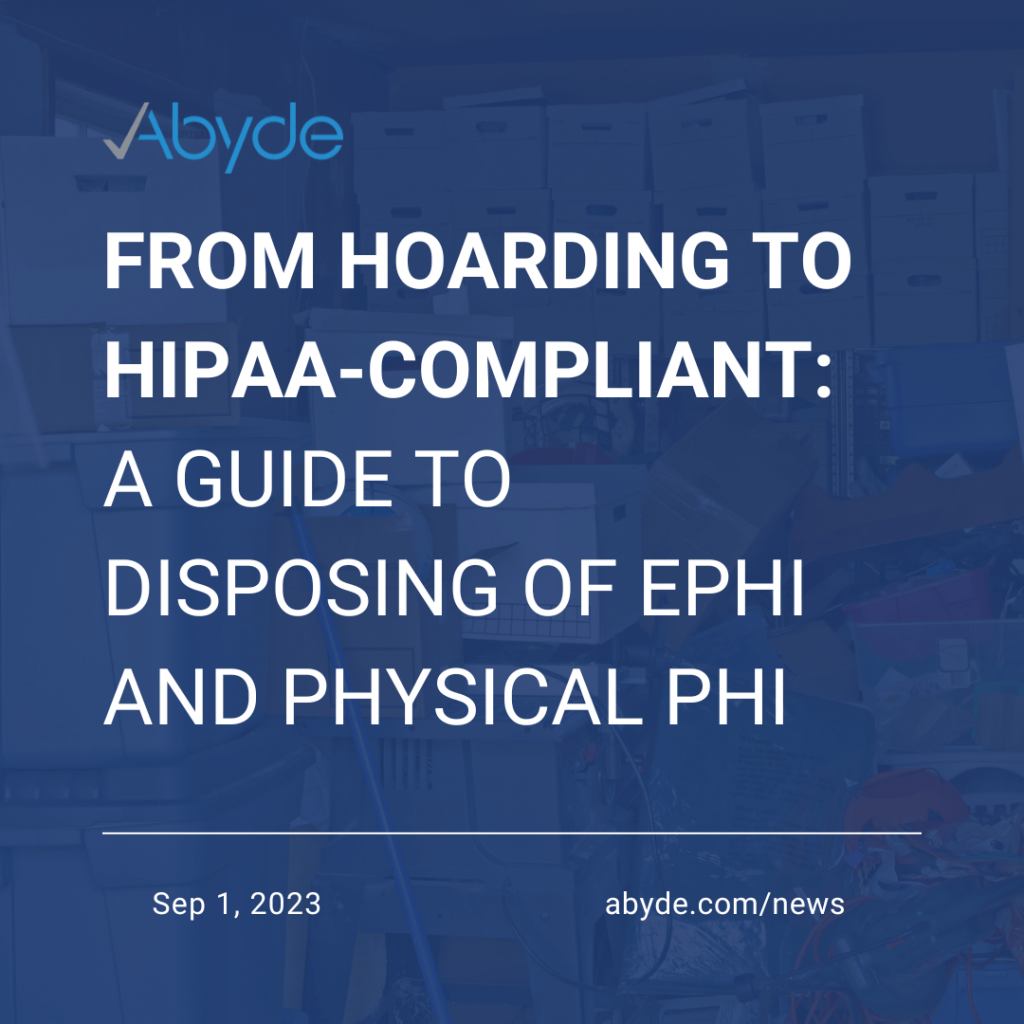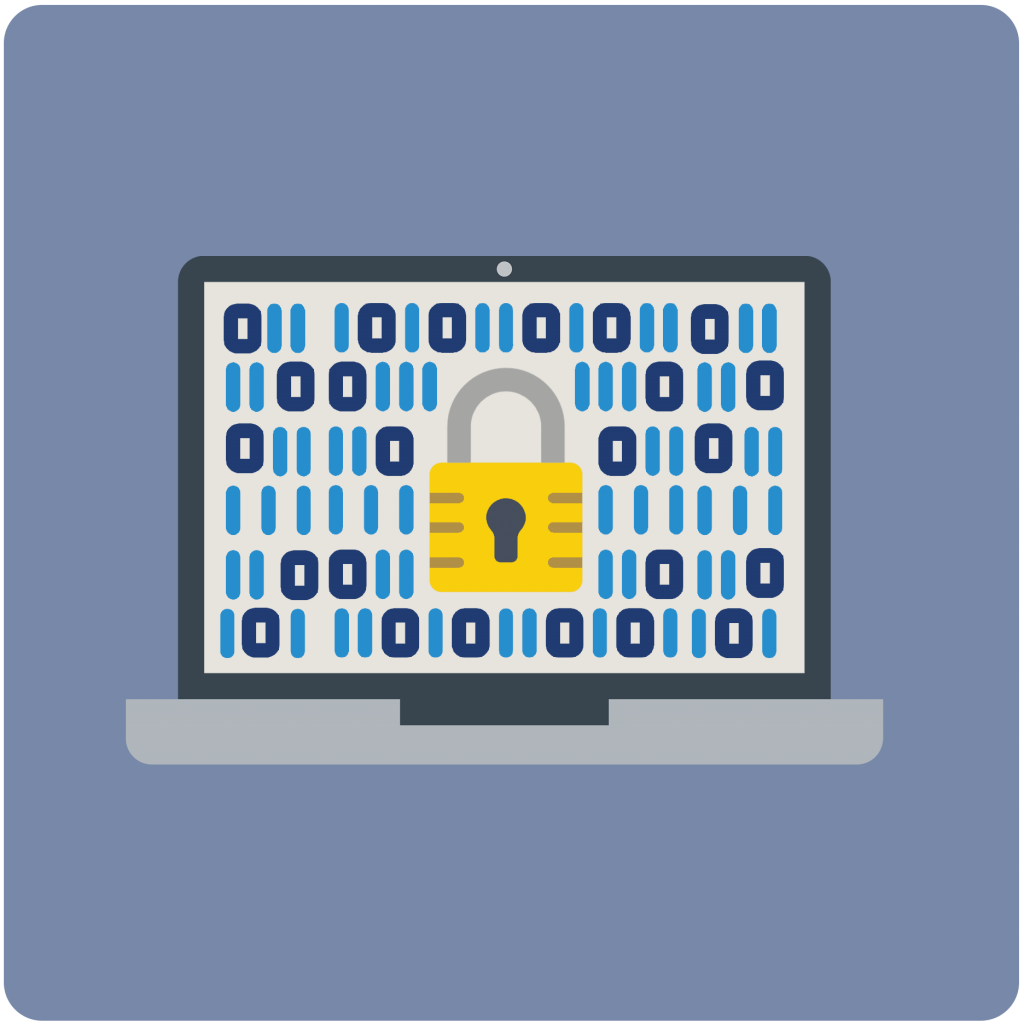September 1, 2023 The TV show ‘Hoarders‘ showcases the struggles of individuals who have an extreme tendency to accumulate and hold on to items, sometimes to the point of causing harm or distress. In a medical practice, holding onto Protected Health Information (PHI) that is no longer needed may not only cause harm and distress but can also lead to severe legal penalties. The Health Insurance Portability and Accountability Act (HIPAA) mandates safeguarding PHI, including its proper disposal when no longer needed. This blog post will guide medical practices on how to dispose of electronic PHI (ePHI) and physical PHI in a HIPAA-compliant manner. Understanding ePHI and Physical PHI ePHI refers to any PHI that is created, received, maintained, or transmitted in electronic form. This includes information stored in electronic health records (EHR), electronic billing records, digital images, and any other electronic documents containing PHI. Physical PHI refers to any PHI that is in a physical form, such as paper records, printed images, and other tangible materials containing PHI. The Need for Proper Disposal Just as the individuals on ‘Hoarders’ need to declutter their living spaces to create a safer and healthier environment, medical practices need to dispose of ePHI and physical PHI that is no longer needed to create a safer and healthier environment for their patients’ information. Holding onto old and unnecessary PHI increases the risk of unauthorized access, identity theft, financial fraud, and reputational damage to the practice. HIPAA-Compliant Disposal Methods The HIPAA Privacy Rule requires covered entities to implement reasonable safeguards to limit incidental and avoid prohibited uses and disclosures of PHI, including in connection with its disposal. Additionally, the HIPAA Security Rule requires covered entities to implement policies and procedures to address the final disposition of ePHI and the hardware or electronic media on which it is stored. ePHI Disposal Methods Physical PHI Disposal Methods Proper disposal of ePHI and physical PHI is a crucial responsibility of medical practices, as HIPAA mandates. Failure to properly dispose of PHI can lead to unauthorized access, severe legal penalties, and reputational damage. Just as the individuals on ‘Hoarders’ must learn to let go of items that are no longer needed, medical practices must learn to let go of ePHI and physical PHI that is no longer needed and to do so in a HIPAA-compliant manner. Utilizing Abyde’s comprehensive HIPAA and OSHA Compliance SAAS solutions can help medical practices navigate these complex requirements effortlessly. By implementing and following proper disposal procedures—often simplified and clarified through Abyde’s automated systems—medical practices can create a safer and healthier environment for their patients’ information.
Toothpaste, Baseball, and ePHI
December 2, 2022 Covered entities and business associates, like healthcare providers, that use online tracking technology should be aware of their ePHI management to HIPAA standards OCR Recently Released a Bulletin Outlining the Proper Use of Tracking Tech in Accordance with HIPAA Compliance Have you ever talked about being out of toothpaste at work, and then when you get home there’s an ad for Colgate on your tablet as you decide what to order for dinner? It’s creepy, but it’s efficient. You’ve been targeted and the Colgate marketing department is doing its job. In this example, the transmission of your tracked demographics and shopping habits is not as sensitive as the transmission of your patient’s data. Yesterday, the Office for Civil Rights (OCR) at the U.S. Department of Health and Human Services issued a bulletin regarding the correlation between sharing electronic protected health information (ePHI) and online tracking technology. While we aren’t experts in targeted advertising, we are HIPAA experts. There are rules that apply to regulated entities, like you, when collecting information through tracking technologies or disclosing ePHI to vendors you may be working with. The OCR put it plainly, “Regulated entities are not permitted to use tracking technologies in a manner that would result in impermissible disclosures of ePHI to tracking technology vendors or any other violations of the HIPAA rules.” Do you know if your PHI is being captured through online tracking? Are you monitoring what patient data is being shared with third-party vendors? Even more important, do you use Google Analytics or Meta Pixel – if so, you might want to listen up. Whether you set this tracking up yourself or a third-party agency did, without permissible disclosures from your patients, if their ePHI is shared through the tracking technology, you are putting your practice and patients at risk. Let’s head around the bases to make sure you’re covering your bases. Nice base hit – you made it to first. The first thing you can do is ensure you have Business Associate Agreements (BAA) in place with all third-party vendors, especially those who create, maintain, or receive ePHI. While you’re cross-checking if your vendors meet the definition of a business associate, make sure your agreements denote the permitted use case for ePHI. And the crowd goes wild – way to steal second. Before you think well I’ll just ask the vendor to delete any protected data before they use or save it, that’s not going to cut it. Per the OCR, “Any disclosure of PHI to the vendor without individuals’ authorizations…requires that there is an applicable Privacy Rule permission for disclosure.” Through the Privacy Rule, patients are empowered to have more control over their health information to access and make any changes as needed and boundaries are set on the use and release of health records, including the minimum necessary standard for information disclosures. A bunt from your teammate gets you over to third – nice work! Before we round out to home, ask yourself if the risk is worth the reward. And if you’re still unsure, check in with your Security Risk Analysis and scorecard – another benefit to Abyde’s ongoing compliance. We work with you to identify the potential risk and exposure associated. As we make our way to home base, we will summarize with this: if ePHI is involved in any of the data the tracking technology is sharing, HIPAA rules need to be followed. Here are the final words from the OCR, “all disclosures of PHI to tracking technology vendors are specifically permitted by the Privacy Rule and that, unless an exception applies, only the minimum necessary PHI to achieve the intended purpose is disclosed.”
How Are You Controlling Access to Your ePHI?
July 22, 2021 While there might not be such a thing as a real-life fairy godmother, technology has granted us the power to access a whole world of information with just a click of a mouse. Anything from research, shopping, to chatting with friends is now so simple it almost seems like magic, but this “instant-access” ability is a double-edged sword when it comes to the privacy and security risks that follow in its reign. Now if there’s one industry that truly feels the weight of technologies twofold, it’s healthcare. While sharing, receiving, and storing electronic protected health information (ePHI) is now easier than it ever was before, the heightened number of healthcare data breaches and cyber attacks seen over recent years have identified the ‘Achilles’ heel’ of technology’s power of accessibility. This ongoing battle between ease of access and security risks has been the topic of several Office for Civil Rights (OCR) alerts shared over the past year, and most recently, the main focus of their Summer 2021 Cybersecurity Newsletter. The newsletter titled “Controlling Access to ePHI: For Whose Eyes Only?” highlights a recent report that found that “61% of analyzed data breaches in the healthcare sector were perpetrated by external threat actors.” So while most healthcare organizations know not to go and give the keys of the castle away to just anyone, technology has made access a possibility for really anyone who has a decent internet connection. But the even more striking statistic featured in the newsletter? It’s not just hackers that you have to worry about, the security incident report also uncovered that 39% of those data breaches were actually committed by insiders. Though most fairy-tales feature an evil villain, these insider breaches aren’t always the result of a malicious act. In addition to the multi-million dollar hacking schemes that we see all too often, are stories of staff impermissibly accessing ePHI or leaving sensitive data unattended. So if you’re wondering how you can best protect your practice, the answer is to have the proper authorization policies, procedures, and controls in place. When it comes to those necessary policies and controls, the HIPAA Security Rule identifies certain standards and specifications that healthcare organizations are required to implement. The two standards, Information Access Management and Access Control, are administrative and technical safeguards that work in tandem to protect and secure ePHI – but what exactly do they entail? Information Access Management This standard essentially defines how access to ePHI is authorized and requires HIPAA-covered entities and business associates to implement policies and procedures regarding information access. So, what do some of these specific policies include? Access Control In addition to the administrative requirement for access management, Access Control is a technical safeguard that actually limits the availability of that ePHI based on the organizations’ Information Access Management policy. The OCR’s newsletter describes the necessary controls to coincide with the “flexible, scalable, and technology-neutral nature of the Security Rule” and provides a wide range of control mechanisms for organizations to consider and implement where they see fit. They also provide four implementation specifications which include: So as complementary requirements of the HIPAA Security Rule, your organization is expected to have these standards in place to best prevent both outsider and insider threats. And while it would be nice if you could just have a knight in shining armor there to guard your practice from cyber threats and impermissible ePHI access – implementing the safeguards provided above, and ensuring all staff members are trained on proper access, is the next best thing.
Properly Encrypting ePHI: What Your Practice Should Know
August 20, 2020 Even before COVID-19, electronic solutions were transforming the way practices work and communicate with patients and other providers. As technology continues to evolve within the healthcare industry, it’s important to understand how to properly secure sensitive protected health information (PHI) when stored or transmitted. What does encryption actually mean? Protecting patient data from cyberthreats goes beyond having appropriate passwords. It means having the right technical safeguards in place including properly encrypting any PHI created, stored, sent, or received by your practice. So what exactly is encryption? Encryption means that content containing sensitive data is made unreadable for anyone except those authorized to view the information. This process essentially uses a software or algorithm to ‘lock’ the data or written text and requires an encryption key to make the information decipherable again. What should be encrypted? So what should be encrypted? Simply put, the answer to this question is pretty much anything containing PHI. This includes data that is being sent to someone else such as a patient, business associate, or another provider. Examples of this include: Why does encryption matter? For a typical practice, your EHR system is likely already encrypted – but your EHR isn’t all that matters. All other laptops, external hard drives, servers, and communication systems are at high risk if they are not also properly encrypted to protect from cyberthreats. In fact, failing to encrypt devices has been the cause of various HIPAA violations. Recently, a covered entity in Rhode Island faced a $1,040,000 fine from the OCR on top of a 2 year corrective action plan. The violation resulted from a stolen unencrypted laptop, leading to over 20,000 patients data being exposed. Part of the reason for the hefty fine was the organization’s “systemic non-compliance” when it came to proper encryption of devices. The entire incident could have been avoided if the entity had the proper technical safeguards in place. With cybersecurity threats on the rise and electronic communication becoming more commonplace, it’s all the more important to ensure the protection of your patients’ information. Implementing encryption services is a great way to best protect your practice and prevent HIPAA violations. If using an external vendor for encryption, make sure to have the appropriate business associate agreement in place as well.
So You Have PHI to Dispose of – Now What?
February 26, 2020 The days of simply shredding paper records and files to dispose of Protected Health Information (PHI) are behind us as the use of technology continues to become more prevalent within the medical industry. Under the HIPAA Privacy Rule, practices are required to implement the proper administrative, technical, and physical safeguards when it comes to protecting patient privacy. This rule dictates that covered entities are responsible for implementing and maintaining these policies. For many practices, disposing of electronic or regular PHI in the proper way may be daunting. Instead of always shredding a paper file, practices now have to follow recommended methods to dispose of data provided by the U.S. Department of Health and Human Services. These methods include: Without a simple checklist to follow, it is difficult to guarantee that the best measures are being taken to protect this secure data. In fact, covered entities and business associates have been hit with hefty fines for not disposing of PHI properly. RELATED: IS YOUR PRACTICE MEETING HIPAA DATA SECURITY REQUIREMENTS? DOWNLOAD OUR HIPAA CHECKLIST AND FIND OUT! In one well-publicized example, a shredding company left thousands of patient files unlocked and unguarded for anyone to take. The shredding company, as well as the covered entity whose files were left unsecured, were both hit with monetary settlements. Another incident of improper PHI handling left almost 10,000 individuals impacted. In this case, a pharmacy disposed of an electronic device used for customer signatures without properly wiping the device first. This exposed a vast amount of PHI including patient names and signatures along with prescription numbers and medication names. Many of these incidents occur due to the lack of policies set in place by the practices for business associates and other outside parties handling patient data. Another case that led to monetary penalties totaling a whopping $140,000 resulted from a medical billing company disposing of 67,000 patient records in a public dumpster. Unfortunately, improper disposal of PHI is the source of many data breaches and HIPAA violations. Implementing the correct policies for disposal of PHI is paramount, and each employee must be trained on proper PHI disposal to ensure that your practice is taking every step possible to keep protected health information secure.



